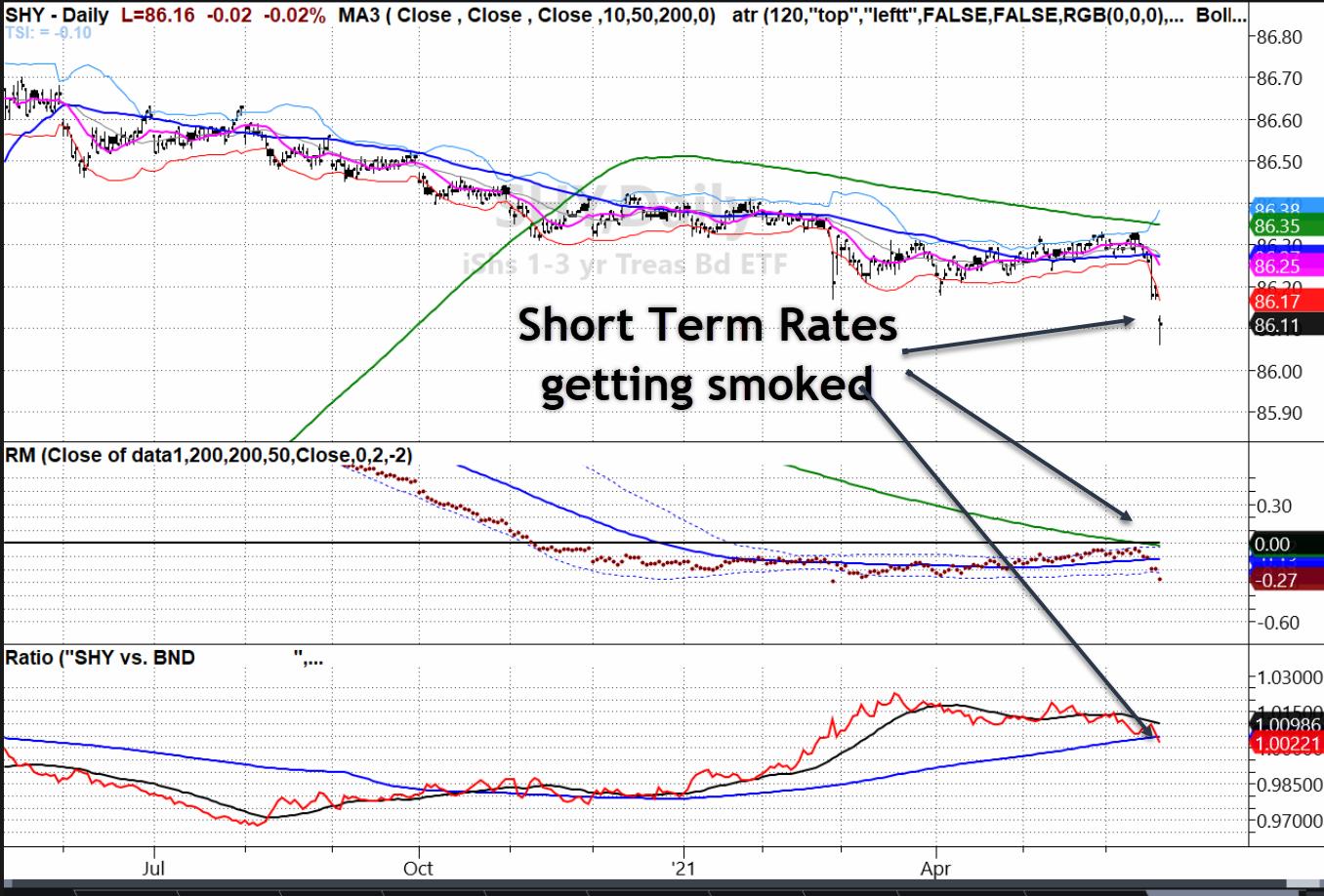Last week, we heard from the Federal Reserve that there will be no change in the guidance for monetary policy in the immediate future. Rates will remain low for the time being, and by low, I mean near zero.
This excessively cheap monetary environment allows debt to be created with virtually no end in sight. This easy money policy is responsible for the potential hyperactive spike in inflation.

We are seeing prices rise across the board, everything from avocados to rental cars, to the price of your home is on the up & up. Reports of massive overbidding in the price of housing as buyers recklessly attempt to acquire everything in sight while rates are so low. It could be argued that the current state-of-affairs is unsustainable.
Now, lets look at what this Fed announcement (or lack thereof) has done to the market last week. The S&P 500 SPDR® S&P 500 (NYSE:SPY) and Dow Jones SPDR® Dow Jones Industrial Average ETF Trust (NYSE:DIA) saw a harsh sell-off Thursday and Friday, both breaking under their 50-DMAs, and having momentum indicators spell out the beginning of longer-term bearish trends.
No doubt the dip will be met with mountains of newly minted currency, created in a last chance attempt to keep the economy and the market afloat. The S&P 500 closed under a critical support level at $416.50, and in the final minutes of trading futures broke over $30 from 4175 to 4142 to close the week on the low.
Commodities took a big hit as well with the sole exception of Crude Oil (NYSE:USO) which ended the week slightly positive. Precious metals were not spared by market sell-off despite traditionally being used as inflationary hedges, with (NYSE:GLD selling off over $50 in the wake of Wednesday’s announcement. The dollar’s rally pressured gold along with rising short term rates.
One sector that has so far been able to resist the sell-off has been clean energy, led by Solar Energy—Invesco Solar ETF (NYSE:TAN). This sector has gained major political support nearly worldwide, with a transition to clean energy emerging across transportation, Industrial and retail sectors.
We will be watching how the Fed continues to manage the treasury market. In the meantime, the lack of action from the Fed has proven to be detrimental to a recovering market, with no changes creating fear, uncertainty, and doubt across every asset class.
The flattening yield curve needs to be monitored (watch for inversion) as it has been a reliable economic indicator for market selloffs.
Last week’s market highlights
- 3 of the 4 key US equity benchmarks weakened to warning phases with some of the weakest TSI readings (Trend Strength Indicators) in months [Invesco QQQ Trust (NASDAQ:QQQs were the exception].
- Our Real Motion indicator showed a constant decline in momentum across all 4 key equity benchmarks
- Risk Gauges remained neutral with a slight improvement despite the sell-off
- Volume patterns across the key indices continued to stay weak
- Volatility (VXX) bounced off recent lows, corresponding to sell-off in the key equity indexes
- The number of stocks above the 10-DMA were showing the beginning of oversold readings for both the S&P 500 (SPY) and the Russell 2000 (IWM)
- All commodities got hit hard, including softs, industrial metals and precious metals
- The one exception in terms of commodity prices was Crude Oil (USO) which closed positive on the week
- McClellan Oscillator tanked for SPY and was in a strong risk-off mode
- Interest rates (TLT) dropped sharply, confirming TLT’s breakout from a multi-month base
- High-yield debt (HYG) continued to underperform vs TLT
- Although a bit early to tell, watch for a possible recession signaled by flattening of Yield Curve as short-term rates rose last week while long term bond rates fell
- Value stocks (VTV) have broken down and gone into a warning phase, while Growth stocks (VUG) moved up to new all-time highs and resisted the sharp sell-off, and still not overbought
- 4 of the 6 members of the Modern Family have moved into a warning phase, a clear risk-off indicator
- Semiconductors (SMH) are in a long-term compression formation and still in a bullish market phase
- Solar Energy (TAN) led all sectors this past week, with a 5-day increase of 3.32% while nearly every other sector was negative
- The US Dollar (UUP) rallied sharply, but on the weekly charts remains in a bearish stack
The week in Crypto
To say that it has been a hectic week for cryptocurrencies would be an understatement, as each week we see this financial and technological paradigm shift gain more traction. The highly anticipated Fed announcement on Wednesday created turbulence across nearly every asset class, with cryptos being no exception.
If anything, the cryptocurrency market has shown continually closer correlations to traditional stocks even though Bitcoin (BTC), the industry’s leader, has historically been uncorrelated to any other market up until 2020. Identifiable correlations between BTC vs. SPY and BTC vs. GLD have emerged during the most recent crypto cycle due to increased adoption by traders of traditional markets.
The correlation between BTC and GLD has emerged as a clear inflationary play, with Bitcoin often being referred to as ‘digital-gold’ due to its use as a store of value against inflationary pressures. However, this comparison has been losing traction due to BTC’s continual volatility and reaction to macroeconomic events.
Many analysts are going as far as beginning to call Bitcoin ‘digital-copper’ as it has historically performed better in Risk-On situations, while gold is an obvious Risk-Off hedge. Our Triple Play indicator has successfully picked up on this trend in recent weeks, as Bitcoin and gold now appear to be opposing inflationary assets.
We have also identified an increasingly closer correlation between Bitcoin and stocks, specifically the S&P 500. There are several factors that contribute to this trend, with the biggest being the growth of retail trader influence in the stock market and the flooding of institutional funding of the cryptocurrency market.
The shift of investment interests on both sides of this spectrum has exposed large institutions to emerging technologies and cryptos that they have resisted for years, while retail traders that have supported cryptos for years are now using their trading experience to expand further into stocks (bringing the mob mentality with them).
There is no more obvious indication of this trend than the emergence of meme stocks, resulting from retail traders working together to create never-before-seen stock situations that resemble the volatility of the crypto market. Now, only time will tell if the retail trader movement can keep in stride, or if the institutional and governmental stakeholders will snub them out.
Bitcoin started last week strong, testing resistance at the $41,000 level despite a daunting technical setup. Wednesday’s Fed announcement saw BTC begin to sell-off due to inflationary uncertainty, one of the most prominent forms of FUD (Fear, Uncertainty, Doubt) across markets last week.
Heading into the weekend, BTC traded to an even lower range, testing support around $35,500. This was likely also being fueled by the anticipated death cross of BTC’s key moving averages that has been in the woodwork since the crypto market crash in early May. If BTC loses support at $35,500, look for support at the June low around $31,000.
If you are looking for an emerging trend in the crypto space, Polygon (MATIC) has gained a ton of traction in the last month. The Polygon network is designed as a scalable blockchain to ease Ethereum (ETH) in its growing pains. Essentially, Ethereum got too big too fast, creating oversaturation of the network’s underlying blockchain, which caused transaction fees to increase while transaction speeds decreased.
While the world waits for the second most popular cryptocurrency to implement major updates to their network, Polygon has emerged as a temporary fix to Ethereum’s recent technological pitfalls and has the potential to claim a spot as a top currency powered by the momentum of the DeFi (Decentralized Finance) space. Many are already hailing Polygon as an ‘Ethereum Killer,’ so keep an eye out for this altcoin to continue its growth even in a recently bearish market.
